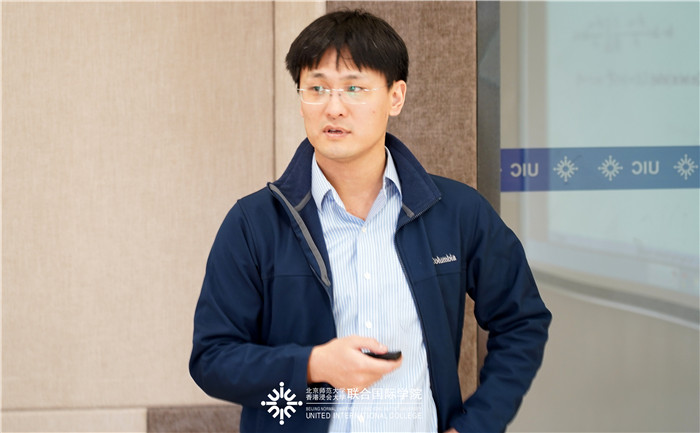Comparing equations for finding the mean
Assistant Professor at the Hong Kong Polytechnic University, Dr Li Buyang, gave a lecture as part of the Institute of Mathematical Research (IMR) and the Division of Science and Technology (DST) lecture series. Dr Li’s lecture was titled ‘A convergent Evolving Finite Element Algorithm for Mean Curvature Flow of Closed Surfaces’.

Dr Li Buyang explaining different equations
The Dean of DST Prof Huang Huaxiong introduced Dr Li by giving a background on his academic career before Dr Li began the lecture. Dr Li, whose research interest is developing novel numerical methods for solving nonlinear partial differential equations in physics and geometry, began the lecture by proposing a new method to approximate the mean curvature flow of closed two-dimensional surfaces.
He gave examples of mean curvature, as well as showing the equations of the flow including Dziuk’s equation. The numerical method proposed combines evolving finite elements, whose nodes determine the discrete surface like in Dziuk’s method, and linearly implicit backward difference formulae for time integration.
Dr Li’s proposed method differs from Dziuk’s approach in that it discretizes Huisken’s evolution equations for the normal vector and the mean curvature uses these evolving geometric quantities in the velocity law projected to the finite element space.
The error analysis combines stability estimates and consistency estimates to yield optimal-order H1-norm error bounds for the computed surface position, velocity, normal vector and mean curvature.

(from left) Prof Huang Huaxiong and Dr Li Buyang
The stability analysis is based on the matrix–vector formulation of the finite element method and does not use geometric arguments. The geometry enters only into the consistency estimates. Numerical experiments illustrate and complement the theoretical results.
At the end of the lecture there was a question and answer section where audience members asked the importance of proving the convergent in the equation. Dr Li explained the equation was opened and not fully solved when he joined the university and since his background was in this area, he decided to tackle it.
Reporter/Photographer: Samuel Burgess
Editors: Deen He, Lauren Richardson
(from MPRO)
